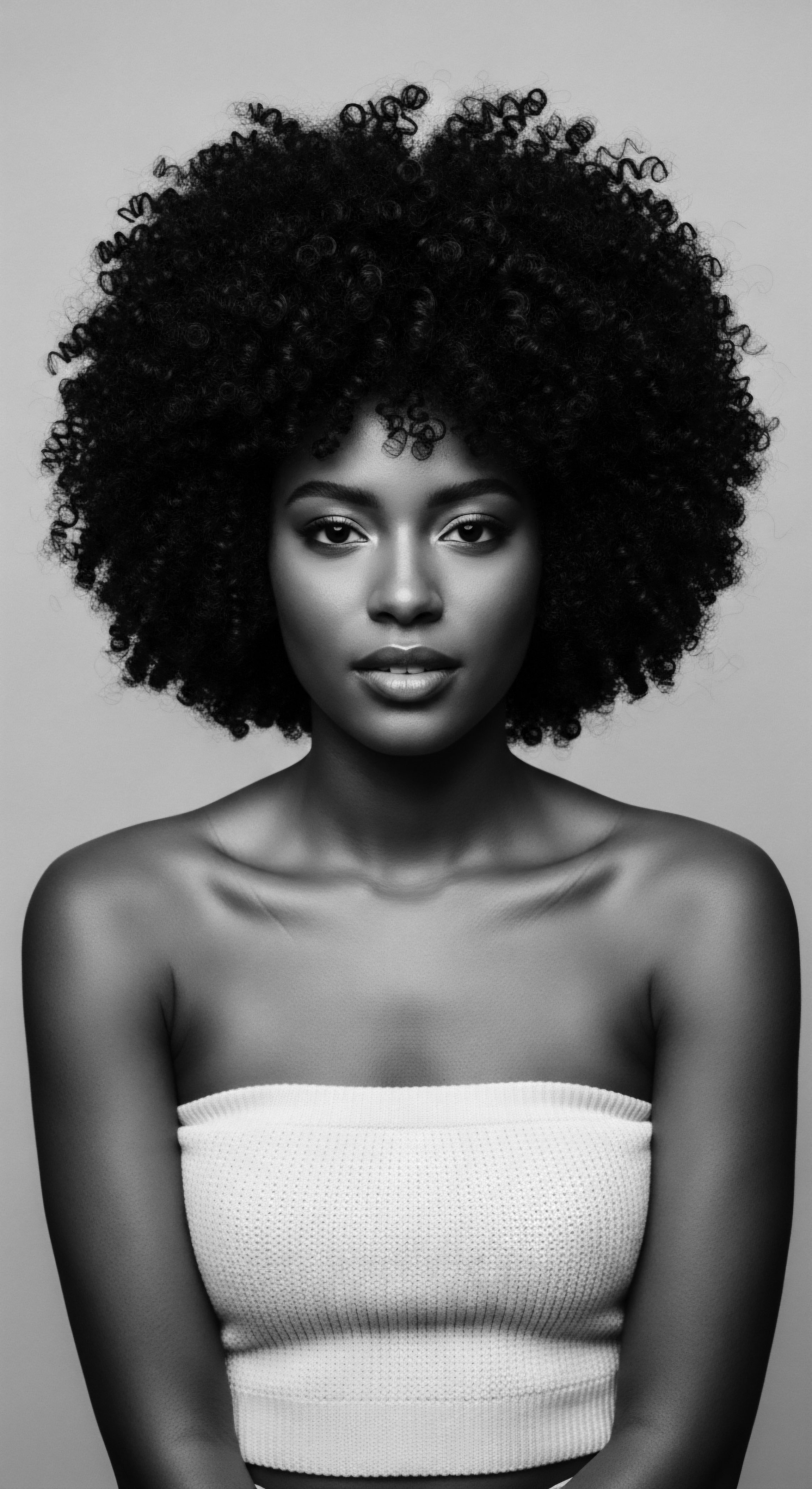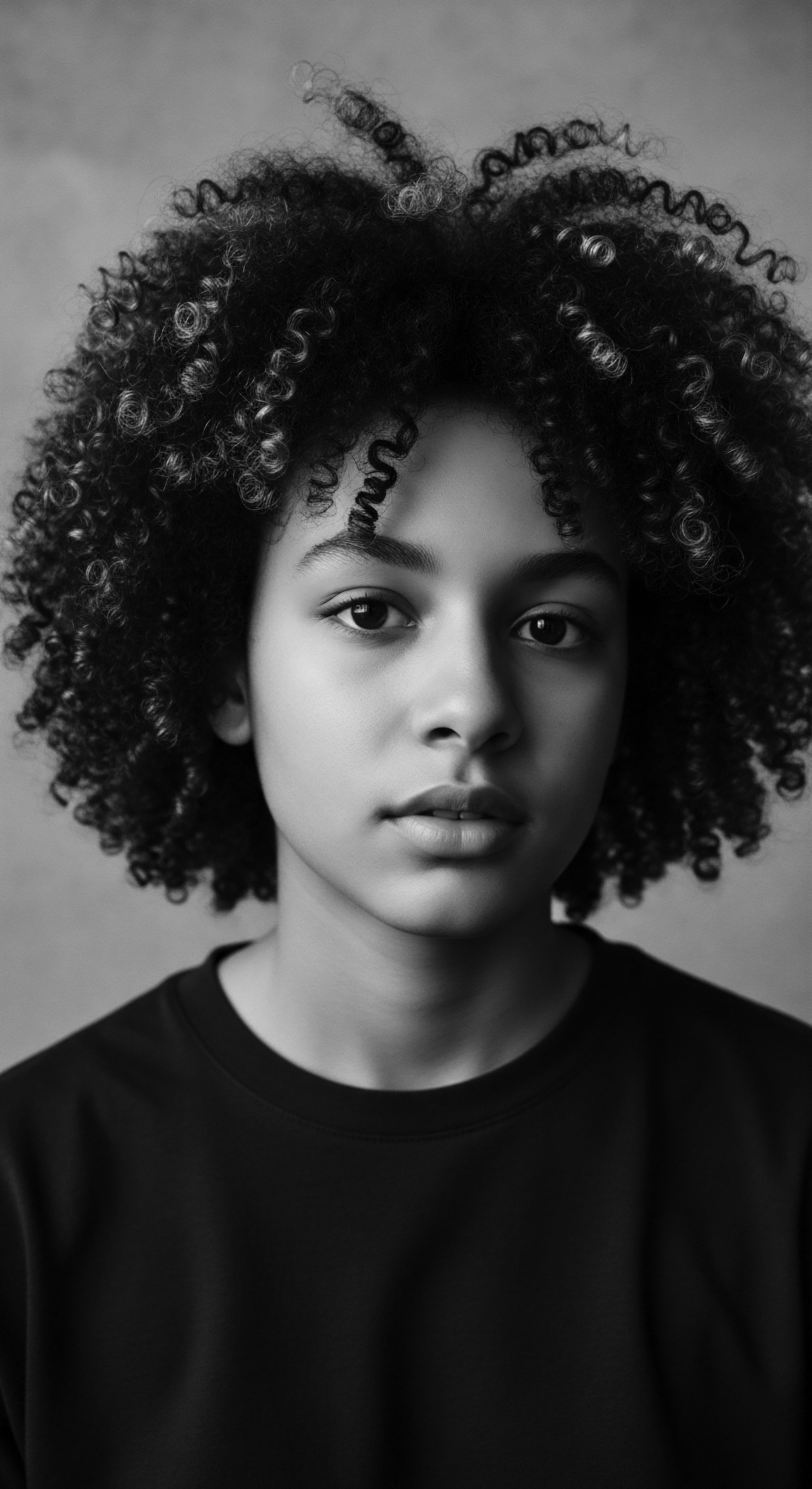
Fundamentals
A hair care regimen, at its most elemental, represents a deliberate, sequential pattern of practices and product applications aimed at maintaining the health, vitality, and aesthetic integrity of one’s hair. This simple elucidation, however, barely scratches the surface of its profound significance, particularly when considering the rich, intricate heritage of textured hair. For countless generations, the careful tending of hair has been far more than a routine; it has been a sacred ritual, a communal gathering, and a silent conversation with ancestry. The delineation of a regimen, therefore, extends beyond mere steps; it becomes a dialogue between the individual and the living legacy carried within each strand.
The initial understanding of a hair care regimen begins with foundational steps, often rooted in universal principles of hygiene and conditioning. These typically encompass cleansing, conditioning, and providing protective moisture. Yet, even these seemingly straightforward actions hold layers of cultural resonance. The act of washing, for instance, might echo ancient purification ceremonies, where specific botanicals were chosen not only for their cleansing properties but for their spiritual significance.
The application of oils and butters, a cornerstone of many textured hair regimens today, finds its echoes in age-old traditions of anointing and sealing, passed down through oral histories and embodied wisdom. This early interaction with hair care is an invitation to perceive the hair strand not merely as a biological filament but as a vessel of ancestral memory, an ‘Echo from the Source’ that connects us to the very origins of human adornment and self-preservation.
A hair care regimen is a structured sequence of practices and product applications, a fundamental ritual connecting individuals to the living heritage of their hair.
The very concept of a regimen implies a commitment, a regular dedication to the hair’s well-being. This commitment, for individuals with textured hair, is often born from a deep, inherited understanding of their hair’s unique physiological needs and its historical vulnerability. From the earliest days, communities learned to interpret the language of their coils and kinks, discerning what truly sustained them amidst varying climates and circumstances. This intuitive knowledge formed the bedrock of early hair care systems, long before the advent of modern scientific classification.
- Cleansing ❉ The initial removal of impurities, often achieved historically through natural clays, plant saponins, or fermented grains, setting the stage for subsequent care.
- Conditioning ❉ The restoration of softness and pliability, frequently accomplished with nutrient-rich plant infusions, fruit pulps, or seed extracts.
- Moisturizing ❉ The retention of hydration, a critical practice for textured hair, traditionally involving a generous application of natural oils and butters to seal in moisture.
Each of these foundational elements, while seemingly simple, forms a delicate interplay that nurtures the hair. The precise order and method of application, even at this rudimentary stage, represent the nascent stages of a regimen, an intuitive response to the hair’s call for care. This early, fundamental understanding serves as the gateway to appreciating the deeper cultural and scientific complexities that define a comprehensive hair care regimen.

Intermediate
Moving beyond the basic interpretation, a hair care regimen signifies a more sophisticated, intentional framework of care, meticulously designed to address the distinct characteristics of textured hair. This systematic approach recognizes that hair, like a delicate ecosystem, thrives when its specific needs are met with consistency and understanding. The import of such a structured system is magnified when considering the inherent variations within textured hair itself—differences in curl pattern, density, and porosity all dictate nuanced approaches to care. This deeper exploration of hair care regimens bridges the foundational knowledge with a more intricate understanding of hair biology and its symbiotic relationship with ancestral wisdom.
For centuries, long before scientific laboratories could precisely measure porosity or density, ancestral practitioners possessed an uncanny discernment for their hair’s requirements. This knowledge was often transmitted through the ‘Tender Thread’ of intergenerational teachings—mothers instructing daughters, elders guiding younger kin in the intricate art of hair tending. These were not merely lessons in aesthetics but profound lessons in self-sufficiency, resilience, and cultural continuity. The specific botanical concoctions, the rhythm of weekly wash days, the patient hours spent detangling and braiding—all these components formed the unwritten curriculum of a living, evolving hair care regimen, deeply interwoven with communal life.
An intermediate understanding of hair care regimens involves recognizing hair’s distinct characteristics and applying structured care methods, often informed by inherited wisdom and community practices.
Consider the widespread historical reliance on natural oils and butters across African and diasporic communities. Shea butter, for instance, sourced from the karite tree, has been a staple for millennia across West Africa. Its rich emollients and protective properties were not discovered through modern chemical analysis but through generations of experiential knowledge.
Similarly, the use of various plant mucilages—like those from hibiscus or flaxseed—for slip and detangling speaks to an innate understanding of hair’s need for gentle manipulation, a practical wisdom that predates contemporary scientific explanations of polymer structures. These practices, though ancient, formed sophisticated regimens that implicitly addressed the very principles of moisture retention and cuticle smoothing that modern science now explicates.
| Traditional Ingredient Shea Butter (Vitellaria paradoxa) |
| Ancestral Application/Significance Used for deep conditioning, skin protection, and sealing moisture; revered for its nourishing properties. |
| Contemporary Hair Care Benefit/Scientific Link Rich in fatty acids (oleic, stearic) and vitamins A, E, F; forms a protective barrier, reduces transepidermal water loss, provides emollience. |
| Traditional Ingredient Black Soap (Alata Samina) |
| Ancestral Application/Significance A traditional cleanser from plantain skins, cocoa pods, and palm kernel oil; used for purifying hair and scalp. |
| Contemporary Hair Care Benefit/Scientific Link Contains natural saponins and mild exfoliants; gently cleanses without stripping, soothes scalp conditions. |
| Traditional Ingredient Aloe Vera (Aloe barbadensis miller) |
| Ancestral Application/Significance Applied as a soothing gel for scalp irritations, conditioner, and growth stimulant in various African cultures. |
| Contemporary Hair Care Benefit/Scientific Link Contains proteolytic enzymes that repair dead skin cells on the scalp, acts as a natural humectant, and provides anti-inflammatory properties. |
| Traditional Ingredient Chebe Powder (Croton zambesicus) |
| Ancestral Application/Significance Chadian women's traditional secret for length retention, applied as a paste to hair strands. |
| Contemporary Hair Care Benefit/Scientific Link Believed to strengthen hair shafts and reduce breakage by forming a protective coating, allowing for significant length preservation. |
| Traditional Ingredient These ancestral ingredients demonstrate a deep, empirical understanding of hair's needs, forming the historical bedrock of textured hair regimens. |
The delineation of an intermediate hair care regimen often involves a conscious choice of products and techniques that honor both ancestral wisdom and contemporary advancements. It might include techniques such as pre-pooing with oils, co-washing to preserve natural oils, deep conditioning treatments, and protective styling. Each of these steps, while seemingly modern, can be traced back to similar protective or restorative practices employed by ancestors, adapted and refined over generations.
The selection of a particular regimen becomes a statement of identity, a personal interpretation of inherited practices, and a mindful engagement with the unique requirements of one’s own hair. This level of understanding underscores the regimen not just as a set of rules, but as a living, adaptable framework for nurturing one’s textured hair heritage.

Academic
From an academic perspective, a Hair Care Regimen transcends its colloquial meaning as a mere sequence of actions; it stands as a complex, culturally embedded system of self-care, identity formation, and socio-economic agency, particularly pronounced within communities of the African diaspora. The rigorous elucidation of this term demands an interdisciplinary lens, drawing from anthropology, ethnobotany, sociology, and material science, to fully grasp its profound significance. It is not simply a biological necessity but a dynamic cultural construct, a performative act of resilience, and a historical testament to the enduring spirit of a people. This interpretation posits that a hair care regimen is a deeply meaningful, often intergenerational, praxis through which individuals and communities articulate their relationship with their heritage, navigate societal perceptions, and sustain holistic well-being.
The meaning of a hair care regimen, especially for those with textured hair, is inextricably linked to a history marked by both oppression and profound cultural preservation. Hair, in many African societies, was a visual language, communicating social status, marital status, age, spiritual beliefs, and tribal affiliation. The elaborate coiffures and meticulous care practices were integral to communal identity and individual expression.
The brutal disruption of the transatlantic slave trade attempted to strip away these cultural markers, forcing enslaved Africans to conform to imposed standards that often demonized their natural hair. Yet, even in the face of such dehumanization, hair care regimens, often clandestine and resource-scarce, became vital acts of resistance and continuity.
A hair care regimen, particularly for textured hair, represents a culturally embedded system of self-care, identity formation, and socio-economic agency.
Consider the profound economic and social impact of hair care within African American communities post-emancipation. The early 20th century saw the emergence of a vibrant, self-sustaining Black beauty industry, largely spearheaded by Black women. This was not merely about commercial enterprise; it was a response to systemic neglect and racial discrimination within mainstream markets. As documented by historians like Noliwe Rooks in Hair Raising ❉ Beauty, Culture, and African American Women (2016), the establishment of beauty schools and product lines, often distributed by door-to-door agents, created pathways to economic independence for thousands of Black women who were otherwise denied opportunities.
These women, through their hair care products and services, provided not only a means for personal grooming but also fostered spaces of community, knowledge exchange, and political organizing. The very act of engaging in a hair care regimen, then, was an act of economic empowerment and cultural affirmation, a direct counter-narrative to prevailing racist beauty standards. The products themselves, often formulated with traditional ingredients adapted for a new context, became tangible links to ancestral practices, embodying a continuous thread of care and innovation. (Rooks, 2016).
The explication of a hair care regimen within this academic framework also necessitates an examination of its psychological and sociological dimensions. For many with textured hair, the daily or weekly engagement with their hair is a deeply personal and often emotionally charged experience. It is a moment of quiet introspection, a connection to the physical self, and a negotiation with societal ideals of beauty. The journey of discovering and refining one’s regimen can be a path toward self-acceptance and a rejection of Eurocentric beauty norms, symbolizing an ‘Unbound Helix’ of identity.
This process often involves unlearning inherited prejudices about one’s natural hair and reclaiming ancestral practices. The choice of styling, the selection of products, and the very act of tending to one’s hair become expressions of personal and collective identity, a living declaration of heritage.
Furthermore, the academic lens scrutinizes the scientific underpinnings that validate many traditional hair care practices. For instance, the long-standing practice of “protective styling” (e.g. braids, twists, locs) within African communities, designed to minimize manipulation and breakage, finds strong scientific corroboration in modern trichology. Research into the unique helical structure of textured hair, its propensity for dryness due to elliptical cross-sections and fewer cuticle layers, and its vulnerability to mechanical damage, scientifically justifies the ancestral emphasis on moisture retention and low-manipulation styles.
The delineation of a comprehensive hair care regimen, therefore, represents a sophisticated synthesis of empirical ancestral knowledge and contemporary scientific understanding, each informing and enriching the other. It is a testament to the ingenuity of past generations whose intuitive understanding of hair biology laid the groundwork for what we now understand through advanced research.
The continuous evolution of hair care regimens within textured hair communities reflects an ongoing dialogue with history, identity, and scientific discovery. From the elemental biology of the hair shaft to the complex socio-cultural narratives woven into its care, a hair care regimen is a powerful testament to the resilience, creativity, and enduring spirit of those who carry the legacy of textured hair. It is a living archive, continuously being written, strand by strand, by each individual who honors this profound heritage.

Reflection on the Heritage of Hair Care Regimens
The journey through the definition of a hair care regimen reveals far more than a mere set of instructions; it unveils a profound meditation on the enduring spirit of textured hair and its indelible connection to heritage. Each strand, each coil, carries the whispers of generations, a silent testament to the ingenuity, resilience, and boundless creativity of those who came before. The careful tending of hair, passed down through the ages, is not simply about physical upkeep; it is an act of remembrance, a celebration of identity, and a gentle affirmation of belonging. It is a continuous conversation with the past, a living legacy that breathes and adapts in the present.
The ancestral wisdom embedded within these regimens speaks to a holistic understanding of well-being, where hair care was intrinsically linked to communal bonds, spiritual practices, and personal dignity. The rhythmic motions of braiding, the shared laughter during communal styling sessions, the quiet moments of oiling a child’s scalp—these were not isolated acts but threads in a larger, vibrant tapestry of cultural life. This inherited understanding reminds us that true care extends beyond the superficial; it nourishes the spirit, fortifies identity, and connects us to the collective memory of our forebears.
As we navigate the complexities of contemporary life, the hair care regimen remains a powerful anchor to our roots. It stands as a testament to the enduring power of self-determination, a space where individual choice converges with ancestral echoes. The future of textured hair care, then, is not about abandoning the old for the new, but rather about a harmonious blending—a respectful integration of ancient wisdom with modern insights, allowing the ‘Soul of a Strand’ to continue its unbound dance through time, vibrant and deeply rooted in its magnificent heritage.

References
- Byrd, A. & Tharps, L. (2001). Hair Story ❉ Untangling the Roots of Black Hair in America. St. Martin’s Press.
- Chin, E. J. (2018). Natural Hair in the African Diaspora ❉ Identity, Politics, and Culture. Lexington Books.
- Hooks, B. (1992). Black Looks ❉ Race and Representation. South End Press.
- Rooks, N. M. (2016). Hair Raising ❉ Beauty, Culture, and African American Women. Rutgers University Press.
- Opoku, A. (2014). African Traditional Medicine ❉ A Guide to Its Practice. Xlibris Corporation.
- Patton, T. O. (2006). Pushing Our Own Buttons ❉ The African American Women’s Hair Care Industry. University of Illinois Press.
- Banks, I. (2000). Hair ❉ A Cultural History. Rizzoli International Publications.
- Ebony, N. (2019). The Big Book of Hair ❉ A Natural Hair Care Guide. Self-Published.
